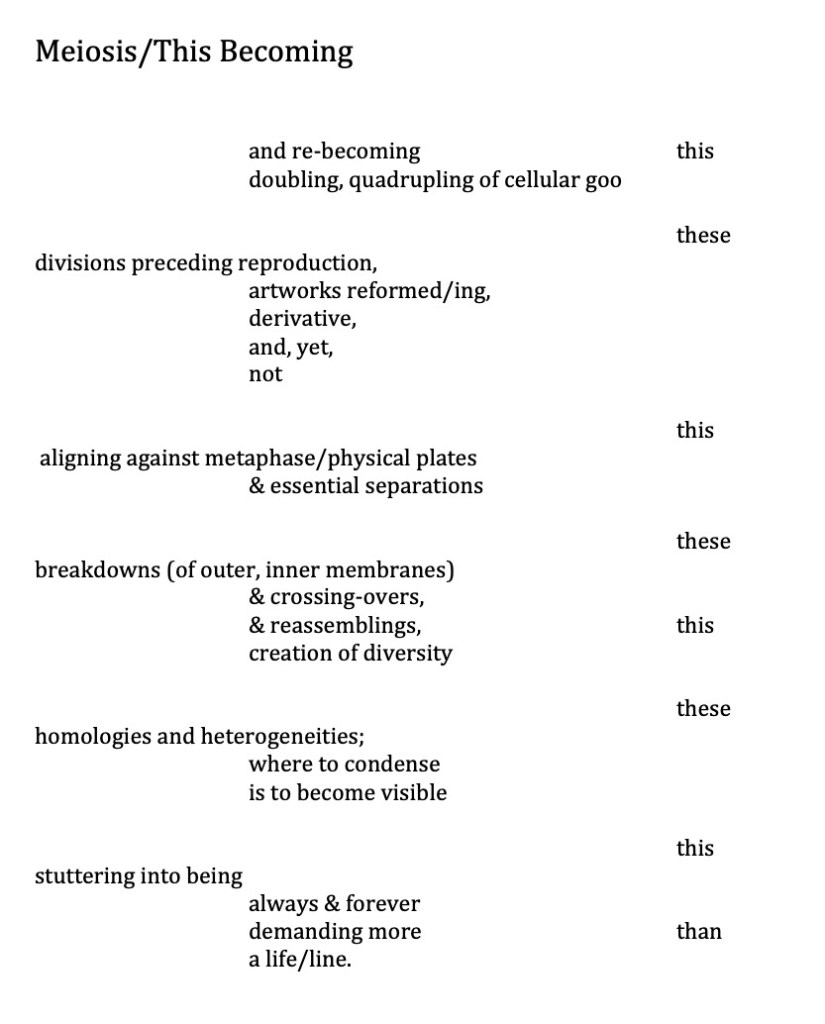Years ago, when I taught introductory biology to university undergraduates, covering the topic of cell division meant guiding students through understanding and memorizing the stages of mitosis (asexual reproduction, essentially cells duplicating existing genetic code) and meiosis (sexual reproduction, where cells divide to create new genetic combinations).
While I directed my students to academic videos such as the hyperkinetic Crash Course video “Meiosis: Where the Sex Starts” or the rather dry instructional video on the phases of meiosis by Bozeman Science, my personal fascination with meiosis didn’t involve all the scientific phases (i.e., prophase I & II, metaphase I & II, anaphase I & II, telophase I & II, cytokinesis) or the specialized terms (haploid, diploid, oocytes, spermatocytes. centromeres, centrosomes, microtubules, chromosomes, etc.).
I was, and am, fascinated with meiosis because it is so mind-blowingly magical.
Meiosis – the process that makes you, you and me, me – is absolutely fascinating.
The first time I saw an animation of the process of meiosis, I was transfixed. Life was begetting life, right in front of me! After decades of seeing meiosis depicted in textbooks as circles and squiggles, when the first video-microscopy of sexual cell division went live, it was a revelation. I could watch genetic code being shared and re-constructed, as living cells did their thing, in a blink of an eye.
For folks who’ve never had the pleasure of seeing meiosis play out in real time, the one-minute video I’ve linked below combines real life footage of mouse and crane-fly cells with animations [and explanations] of meiotic phases.
Translating science into art
When I set out to craft a video from my poem “Meiosis/This Becoming” (full text is at the bottom of this post), I searched for images that mapped onto each phrase and stanza and break in the poem, while also being true to its mood. Each time I chose an image from the Mendocino coastline: from an early morning beach walk or recent tide-pooling expedition, I considered the oceanic origins of life on our planet, and the absolute beauty of the intertidal zone.
I am fortunate to be a member of the Gualala Art Center, an absolute gem nestled in the Norther California redwoods, built and financed by the nearby communities of Gualala and Sea Ranch – neighbors on the north and south sides of the Gualala River dividing Mendocino and Sonoma counties. The Gualala Art Center, surrounded by outdoor sculptural installations, constantly hosts exhibits of local artists and cultural events, open to all.
The Center is home to both the Life Drawing Group (whose portraits of me occasionally grace exhibit walls and win prizes), and my beloved Collage Group, a loose collection of artists who enjoy hanging out together a few times a month and making things. Even more exciting for 2021: our current president of the board is Eric Wilder, a Kashia Pomo graphic artist.
This year’s 60th Art in the Redwoods event at the Gualala Art Center featured the expected – yet delightfully surprising, and often breath-taking – range of paintings, sculptures, drawings, photography, jewelry, pottery, basketry, and multimedia art from our artist-rich coastline community. In this second pandemic year, the artwork was available for viewing in person (by reservation only, in small groups) and online.
Video clips were invited to AIR for a second year in a row, and after spending hours meticulously matching up subtitles to imagery, I submitted my 55-second video poem, viewable on the YouTube link below. It won a wee prize, making the effort all the sweeter.




Fabulous!! Love the images and the way you have blended them with your words, and the music that goes perfectly with it all. 55 seconds of words and beauty that will stay with me far longer.